Rome
From a chance meeting in Paris, 2023, I found a new friend with the same interests as I, and the same wanderlust. She invited me for a week in Tuscany, which turned into a month, traveling from Rome to Amsterdam.
We met up in Rome which was having the same heatwave we were having in New Bern, but undetered, we each had things we wanted to see. I had been to Rome before and had seen a lot of the major sites so I skipped those this time (see my blog post of that trip).
Sheryl and I were only in Rome for 48 hours. We stayed at Hotel Artemidi which was very nice and in a nice neighborhood with shops, restaurants, and historic sites. Even though it wasn’t far from the train station we felt quite safe.
My first visit was to a cathedral near our hotel Santa Maria degli Angeli e dei Martiri. Interesting that it was constructed in the 16th century in a building that was originally built in 306 AD and housed baths the Romans used for about 200 years.




In the same Piazza, Piazza San Bernardo there is the fountain of the acqua felice, also known as the “fountain of Moses,” and three interesting churches (one being the Santa Maria mentioned above), and that of San Bernardo, which gave its name to this square.
The Fountain of the Moses was built in 1587 and is the terminus of an aqueduct built in 1585, the first to be built since ancient times.
Most of the aquaducts in Rome were built from 312 BC to 226 AD. The Aqua Virgo is the only ancient aqueduct that is still in use today; it was built in 22 BC and it supplies water to the Trevi Fountain.


A third church nearby, St. Paul’s Within the Walls is a multi-cultural, multi-lingual Episcopal church built in 1873. It was the first non-Roman Catholic church within the city walls.
There are beautiful mosaics by Sir Edward Burne-Jones and George Breck, and a busy music program offering concerts most days.


Further down our street is the Trajan’s Markets Museum, which is an archaeological complex which represents a neighborhood and its evolution from an administrative center of the Imperial Forums, to a noble residence, to a military fortress, to a convent, to a barracks.

The Museum is located on several levels on the slopes of the Quirinale Hill and is semi-circular. The buildings date from 46 BC to 113 AD. It is a museum of ancient architecture with exhibits of architectural and sculptural decoration of the Fora. It is a fairly new museum that opened in 2007.




I eventually met up with Sheryl and we ended the evening at the Trevi Fountain.
It was just as packed as you see in all the photos. But we found a place to sit so it wasn’t so bad.
I had been up a long time and had walked a lot, I found myself falling asleep while sitting there!

Just a block from the Fountain is Galleria Sciarra with its amazing decorated walls.
This amazing courtyard was built in the late 19th century for the wealthy, influential Sciarra family. It was meant to be a shopping mall, which never happened.
Every inch of the four-story walls enclosing the space is covered by frescoes of women and men surrounded by elegant, curling floral designs.
The women are the main focus to, of course, encourage the purchase of clothing.
There is a glass-and-iron ceiling that protects the frescoes, while it is a private building it is open to the public to view during business hours.

The next day I went on a tour of the gardens of the Vatican in an open air bus.
I decided to leave the hotel early and walk so was able to get this photo of the Spanish Steps with no people and some other random shots along the way.









The gardens were lovely and I thought I would be smart and try and go through the museum to save steps walking in the heat. Well, silly me, I made it all the way to the Sistine Chapel only to have to turn around and walk all the way back to the exit. Yes, I realize now I was not supposed to take a photo in the Sistine Chapel but since I did I’ve shown it here.
The gardens cover 57 acres, half the country, and have only been open to the public since 2014. Pope Nicholas III in 1279 moved his residence to the Vatican from the Lateran Palace, enclosing this area with walls. He created an orchard, a meadow and a garden which was the start of what you see today.
The Garden was spread with sacred soil taken from Mount Calvary by Saint Helena, the mother of Emperor Constantine. Through this sign, she wanted to symbolically unite the blood of Jesus Christ with that shed by early Christians, who died because of the persecution of Emperor Nero.













On my last visit I was intrigued with The Mausoleum of Hadrian, also known as Castel Sant’Angelo, however I did not do my homework.
I knew the seventh floor had an open-air bar and it was not to be missed because of the view. What I didn’t know is that you walked up five floors with no stopping before you came to the first Museum floor! The first five floors, a circular ramp wide enough for a team of horses to ride up, was just that, a ramp with nothing to see and only one bench on the way up. I did make it and it was amazing. What a fortress! Walking up those five floors that seem like a dungeon, you would have no idea of the elaborate rooms you would find above.



The Castel was built between 134 and 139 AD by Hadrian as a mausoleum for himself and his family. It then became a military fortress in 401 AD, then the popes turned it into a castle in the 14th century.
Paul III decked it out with the elaborate interior decorations you see today. It is also connected to the Vatican so the pope could hide there in case the Vatican was attacked and get there without being seen.


Rome is getting ready for a huge celebration in 2025 so some of the sites are being renovated. The only one that disappointed me was the Ponte Sant’Angelo with ten marble angels which were all covered.
With just a few hours before leaving town the next morning I took off to Campo de Fiori Market, which was a little disappointing. I was expecting a real market and this has pretty much turned into a tourist trap.

It is on the edge of the Jewish Ghetto where I found some of the Stumbling Stones of Rome. Over the past 29 years, a Berlin-born artist, Gunter Demnig, created stones to preserve the memory of the 11 million victims who perished during the Holocaust. There is one stone for each victim.
So far he has personally placed over 70,000 stumbling stones around the world. Heartbreaking but a wonderful tribute, never forget.
This was the first stone I found, and as our trip continued we would stumble across hundreds more. I could not pass one by without taking a photo to honor that person. Eventually, in Amsterdam, there were just so many I quit taking photos. It was upsetting to me if I saw people walking over them without looking down.





The II Portico di Ottavia is part of the Jewish Ghetto which was built between 27 and 23 BC. Through the millenium, it burned was rebuilt many times. What remains is just a fraction of what was once there, a large public meeting space, two libraries, and an open air museum, and later a fish market. The Latin inscription on the arch says the Conservatori or Magistrates of the Capitoline must be given every fish, from the head down to the first fin, whose length was longer than this stone (but I did not see the measuring stone)!






On my previous trip I saw the white building above but didn’t realize it is just a monument. It was built to celebrate the 50th anniversary of Italy’s unification, the Monument to Victor Emmanuel II— also called Vittoriano, Imperial Palace, or Altar of the Fatherland (Altare della Patria). It was constructed between 1885 and 1927. It’s now a symbol of Rome but it was built with a lot of controversy.
An entire medieval neighborhood had to be demolished to make space for this and it is huge. If you’ve never been to Rome, I think it’s one, if not the most, fascinating cities in the world. It’s like an open-air museum. To me its amazing that there is so much of the Roman city ruins to be seen today. They say what you see if only about one tenth of what there is still there uncovered.
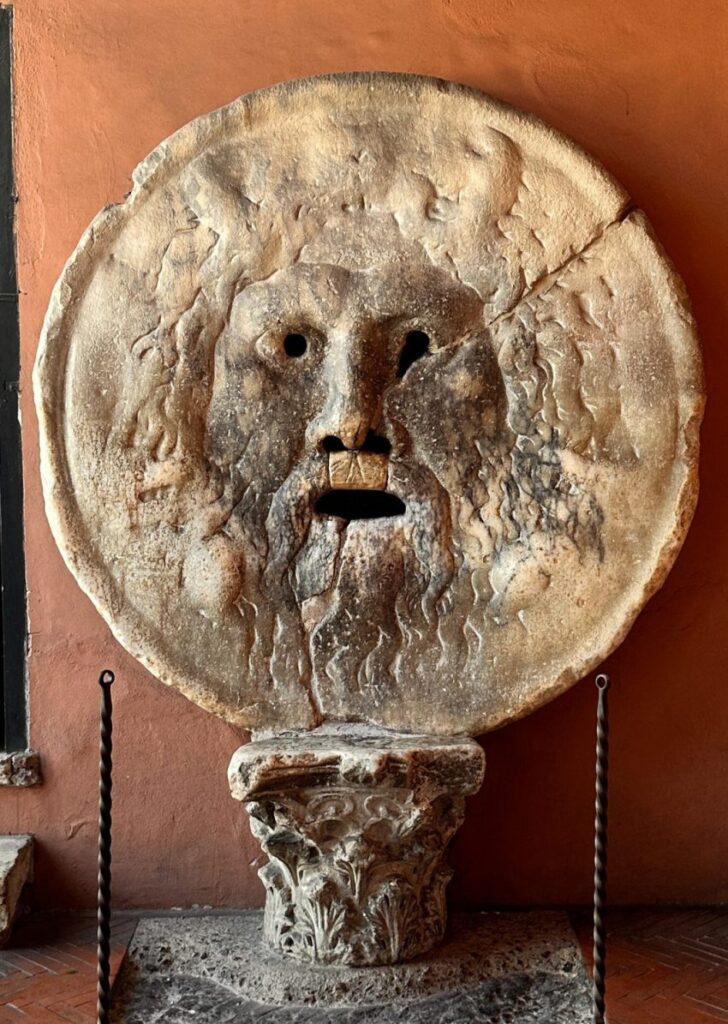
Some people think it’s creepy but I wanted to see the Mouth of Truth which is across the street from the Temple of Hercules. The Mouth of Truth – or Bocca Della Verita, is a large marble mask in the portico of the Santa Maria in Cosmedin Church. Legend has it that if you are a liar and you put your hand in its mouth it will bite it off.
You might remember the scene from Roman Holiday!
Historians suspect it was a cover for a sewer or drain, and it was moved to its present location in the 1590s. Drawings from the 12th century show it laying on the ground near the Church. It weighs 2,900 pounds and measures about 72 inches across and about 6 inches deep.

Across the street from the Mouth is the Temple of Hercules.
The temple is the earliest surviving mostly intact marble building in Rome and the only surviving one made of Greek marble. It was completed in 166 AD. It was a very short visit and even after being there twice there is so much more to see.
Manciano
We rented a car and drove to Manciano, a hill town about 1 1/2 hours north of Rome, where we would be based for a week. It is a pretty town you won’t see in most travel guides and no one speaks English so we got a chance to practice our Italian, or lack of, we were glad to have Google Translate.
It was lovely with lots of restaurants and winding streets which we managed to manuver. One street was pretty tight, I had to back up several times to get around a corner and had just an inch on the drivers side and Sheryl said I had no more than that on the other! Let’s not take that route again I said!

The area has been inhabited since the Bronze Age, and there is a castle on top that was built in 1188.
The Rocca Aldobrandesca is the symbolic building of Manciano, the current structure was built in the 15th century by the Republic of Siena, in the place where the Aldorandeschi had built their castle in the 12th century.
In the center of the square below the Rocca there is a monumental fountain, the work of Vincenzo Rosignoli, which was built in 1913 to celebrate the construction of the Fiora aqueduct.
Among the other interesting buildings in Manciano are the church of San Leonardo dating back to the 15th century but renovated in 1932, the Casa Battiloro formed by two buildings dating back to the end of the 16th century and the 17th century, the Casa Piazai dating back to the end of the 16th century, the more recent Palazzo Aldi built in the 19th century is where the painter Pietro Aldi was born and lived.
In Palazzo Nardelli located near the fortress is the Museum of Prehistory with exhibits from the Paleolithic to the Bronze Age. Unfortunately, the museum was closed the week we were there.











We had a lovely villa in town in walking distance to lots of restaurants and a tiny market across the street and views off our deck over the hillsides.
I loved the fact this guy was out sweeping the streets every day with his broom.





There was a festival going on our first few days but we thought it was a foot race. The tiny, winding, steep streets of the town made it difficult to know what was going on without huffing and puffing your way up the hill.
Later we discovered it was a wine barrel rolling race and we were sorry we missed it! And they have a barrel painting contest during the festival too. The photos are from the city website.


We took road trips most days to different parts of Tuscany.
Pitigliano
Our first day started with that ride through town with the tight corner then we took off for Pitigliano. Unlike many hill towns there is no ZTL zone in Manciano, except for a couple blocks near us that have restaurants. For those blocks they just put up a barricade for a few hours every evening.
I loved Pitigliano! It was one of the prettiest hill towns we saw and while there were some tourists it was really pretty quiet. The Orsini Palace and Museum was fascinating and well worth a visit. I was especially intrigued by the ceilings from the 15th century.



The Palace was originally built as a convent between the 11th and 12th century and was later purchased by the Aldobrandeschi Family as their home in the 13th century.
The town is known as Italy’s “Little Jerusalem,” as it once had a thriving Jewish community and still has a Synagogue.


This whole area is built on and with Tuff rock which is formed from volcanic ash. It has a natural yellowish glow.
The area is also full of caves the Etruscans once lived in but it is first mentioned in writings in 1061.
Walking through the town around every turn was another beautiful photo op.
The Medici Aqueduct was built between 1636 and 1639, and brought running water to the City. It was commissioned by the Medici family.



Saturnia
We were only 8 miles from Saturnia, supposedly the oldest town in Italy. The Etruscans called it Aurinia and the Romans renamed it Saturnia. I can just imagine these ancient people soaking in the hot springs just like we did.
Evidently this had been a swampy area that the Etruscan and Romans drained, but eventually it filled in again and it wasn’t until the 1800s that a local population moved back in.


The hot springs at Saturnia we went to are called Cascate del Mulino and are the most famous spas in Tuscany. They are free and are a beautiful series of cascading falls and natural pools. The water temperature is about 98 degrees. The water of Saturnia has many recognized therapeutic properties and is used to heal the skin, reduce blood pressure and increase lung ventilation. There are showers, a snack bar and lockers to rent.
I had to look up who the Etruscans were. Their culture seemed to date from about 900 BC which was part of the Iron Age which developed from the previous late Bronze Age. We heard a lot about them in the coming week.
Tarot Garden
I did not want to miss the Tarot Garden! Even though I’ve never done much with mosaics (other than working with Isaiah Zagar for a few days in Philadelphia) I’ve still been fascinated by them. The Tarot Garden, Il Giardino dei Tarocchi in Italian, was constructed by Niki de Saint Phalle (1930-2002) and her husband Jean Tinguely between 1974 and 1998. Niki was an French-American sculptor, painter, film maker, artist, and writer.








In the US, MOMA, the Walker Museum of Art in Minneapolis, and the Women’s Museum in Washington, DC, have her work in their collections, just to name a few. I thought her work looked similar to the Stravinsky Fountain in front of the Pompedau Center in Paris, well, that is because she and her husband created that as well.
The Tarot garden is a sculpture garden containing 22 sculptures depicting some of the major cards of the Tarot. Niki even lived in one of the sculptures for 2 years while building the rest of them. The garden is closed in winter months for maintenance. They are very well taken care of and there is a very nice gift shop and snack bar. Some people criticized Niki for making gift items from her designs.
To help fund the building of the Tarot Garden she made and sold perfume, pool balloons, chairs, vases, lamps and other artworks, which raised one-third of the needed financing . She was criticized by people in the art world for her fundraising tactics, which were considered déclassé, but they say she couldn’t have cared less.
I too have been criticized for doing the same thing with my designs (my prints and gift items), but it helped buy me the time to create one-of-a-kind pieces and it also made art available to people that cannot afford original art.

Niki went to Barcelona in 1955 and was enthralled with the work of Gaudi. After seeing his garden she knew one day she would build her own garden of joy. Twenty four years later she would start.
The was just a show in Kansas City of her work I would have liked to have seen. There is a nice article describing it.
Traveling alone – I always have said that at my age I would not be afraid to go to Europe by myself (I have) if I would just go to a city and stay there. But I would not feel comfortable traveling from place to place by myself in a country I did not know the language, especially driving there. Well, after this trip I would not be afraid anymore!
The biggest challenge driving was figuring out how the gas pumps worked, every one was different. However, that was my travel companions job since I was the driver, she is beautiful so men rushed to help her figure them out! I might not have the same luck.
Siena, San Gimignano, and Volterra
This was a long day since we were staying about 2 hours from Siena but the trip was worth it. Of the three Volterra was my favorite, partly because we got to see the pageantry of the Palio del Cero, or Taper Contest, translated to English – a tug of war between 8 teams.
Siena, like other hill towns in Tuscany, was first settled by the Etruscans who inhabited the area from 900-400 BC, by a tribe called the Saina.
The legend goes that the city was founded by Senius and Aschius, two sons of Remus and nephews of Romulus after who Rome was named.
The first known document of the Sienese community dates back to 70 AD:








The crown jewel of Siena is the Siena Cathedral built between 1215 and 1263.
One reason I wanted to go to Siena was to see the Fresco about Good and Bad Government in the Palazzo Pubblico (town hall).
When we asked the ticket taker how to find it she hung her head, it is under restoration! However we were not disappointed because the rest of the building was amazing. Nearly every major room is decorated with Frescos.
Unlike most frescos, the frescos of the Palazzo were commissioned by the city, not by the Church so most depict topics other then religion.













San Gimignano was interesting but not my favorite of the three.
It’s most famous for its towers and the views from the town were spectacular.
Historically, there was a small village here in the 3rd century BC but it was not named San Gimignano until 450 AD when two castles were built.
It seems one major thing to do in the city as a tourist is to go to wine tastings. Since we were driving and not spending the night we did not do that.


As I said, of the three Volterra was my favorite.
The site is believed to have been continuously inhabited as a city since at least the end of the 8th century BC, it was a Bronze age settlement. Today it is best known for being a center for producing Alabaster. There is a Roman theatre, many museums, nice shops and restaurants.
Palazzo dei Priori shown below was begun in 1208 and is the oldest civic building in Tuscany. We just happened to be there when they were getting ready for the tug of war. The introductions and all the fan fair took so long we did not actually stay for the war to begin but seeing all that led up to it was great.















The next day we rested and walked around Manciano, no small feat since there is a lot of up and down, and went out to dinner. For such a small town, 7,000, they have some great restaurants. Two we ate at were LaFilanda (amazing) and Trattoria Il Rifugio.






Pisa and Lucca
I had never been to Lucca and Sheryl had never been to Pisa so off we went. We just stopped to see the leaning tower and it was the first time we saw big crowds. We took the usual photos and did NOT climb the tower. As everyone knows, the tower leans at about 4 degrees and it was built in the 12th century as the bell tower of the Pisa Cathedral.

The story goes that Galileo dropped two canon balls off the top to test the scientific law of free fall and during WWII it was thought the Nazi’s were using the tower for surveillance and it was almost destroyed.



On our way back to the car we took a chance and stopped at a hotel hoping for some coffee. They only served guests but the lady said if we paid cash she would serve us. She was lovely as was the hotel and our drinks.
Lucca was next, the main thing we did was ride around the wall, we were so thankful we got the electric bike! Even then it was interesting (as in not so easy) but it was also a lot of fun. We were too busy steering the bike to take many photos inside the walls.
The city is the birthplace of numerous world-class composers, including Puccini, Alfredo Catalani, and Luigi Boccherini.

I could not believe how long the wall was. The biggest city with an intact wall we had been in. The town dates from the 3rd century BC. Again the territory was settled by the Etruscans, and even Lugurians before that, they occupied the region 2000-3000 years BC, during the Bronze and Iron Age, it makes my head spin thinking about it.
The walls of Lucca are 2.61 miles long. This length corresponds to exactly one tenth of the length of a marathon, and inspired the Lucca Marathon that takes place in October and starts on the city walls. Unlike the other walled cities we were in, Lucca is not perched on the top of a hill.
The walls are among the best preserved Renaissance fortifications in Europe, and replaced earlier medieval and Roman fortifications. The construction of the current walls started in 1504 and were not completed until 1648.
Now I wish we would have had time to explore the rest of the city outside the wall.





Our last day staying in Manciano was one of my favorites.
Montepulciano, Pienza and a brief stop at Montalcino
The driving this day was mostly on side roads with many many curves and the scenery was obviously BEAUTIFUL!






On the way to Montepulciano, we drove by an interesting looking Castel so had to check it out. I can’t find out a lot of information about it but it was an interesting place. There are 2 or 3 short streets of two-story condos that look like they have been there a while, I’m guessing they were barns.
The Castle of Montorio was built by the Alobrandeschi and later transformed into a fortified farmhouse, the walls date to the 12th century. There were a lot of people living there but no one stuck their head out and told us we were trespassing.
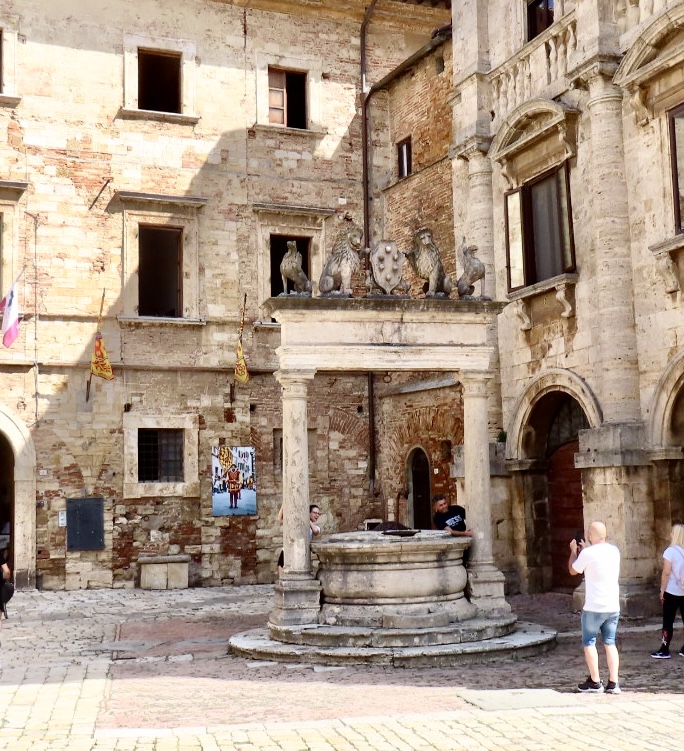
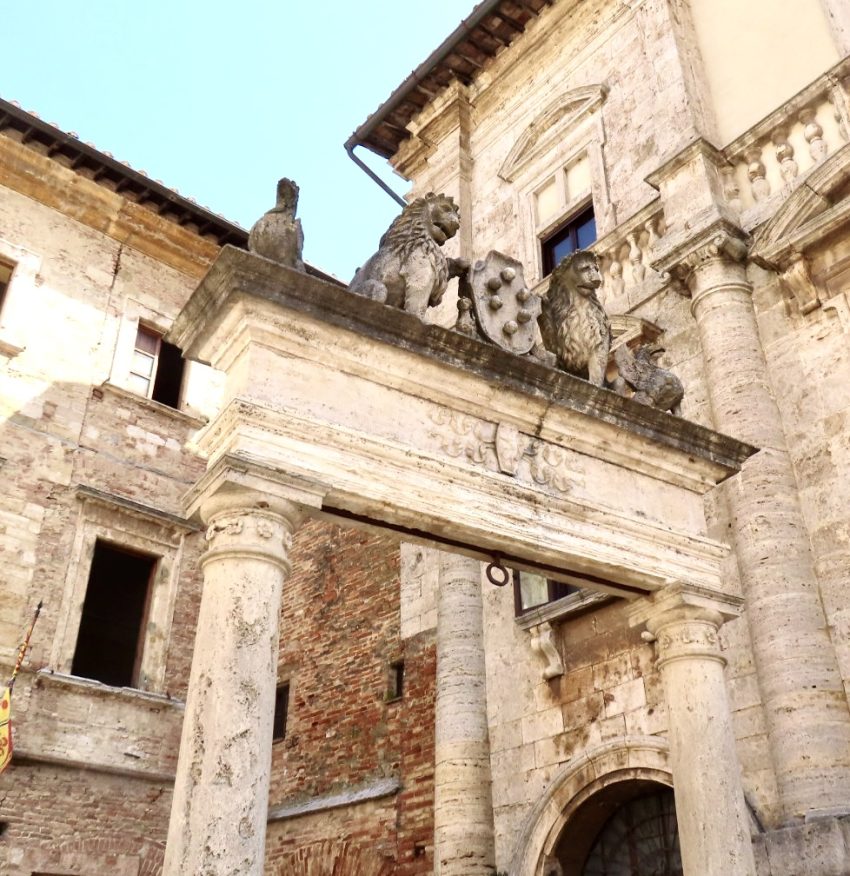
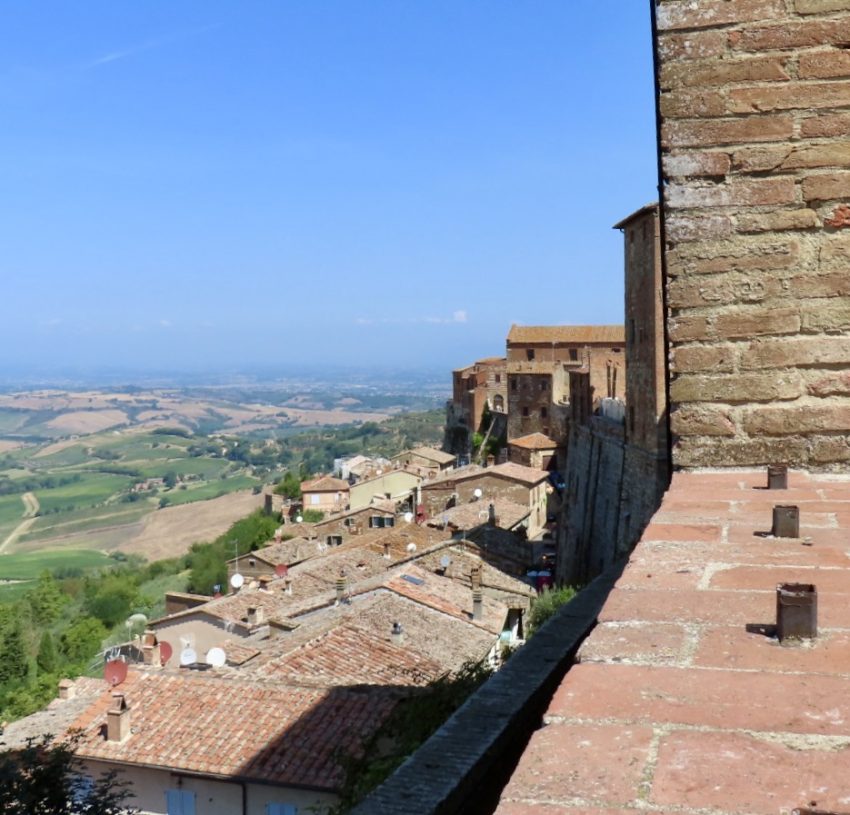

Montepulciano sits on a 1900+ limestone ridge about 80 miles SE of Florence. It was founded in the 4th-3rd Century BC through the centuries it rose and fell in importance. The landscape surrounding Montepulciano was the prettiest we had seen in Tuscany . The biggest attraction for us in addition to the landscape was the square. This was the hill top city that was the hardest to find a place to park. In most of them we did quite well finding a spot.








Pienza was next. I LOVED Pienza, parking was plentiful and convenient, and the new part of the city was just as pretty as the walled part. It was the easiest to visit of all the hill towns and in the middle of the most beautiful landscape.
We started to take the Path of Art and Soul to see the artists benches, made from stone, but quickly realized if we walked DOWN to see them we would have to walk back UP and we had done plenty of that, so decided to drive to see the rest.
The Village is known as the ideal city of the Renaissance, created by Pope Pius II. Before the village was renamed Pienza its name was Corsignano. It was first mentioned in documents from the 9th century. Around 1300 parts of the village became property of the Piccolomini Family, Aeneas Silvius Piccolomini was born here in 1405 and became Pope Pius II. He totally redesigned the city to be the utopian hill town.

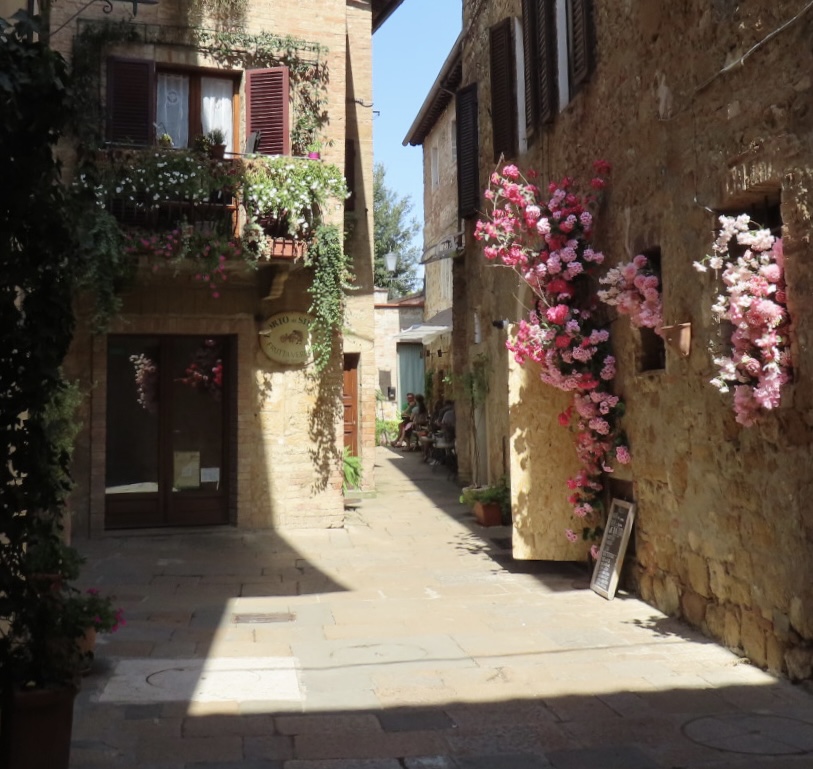
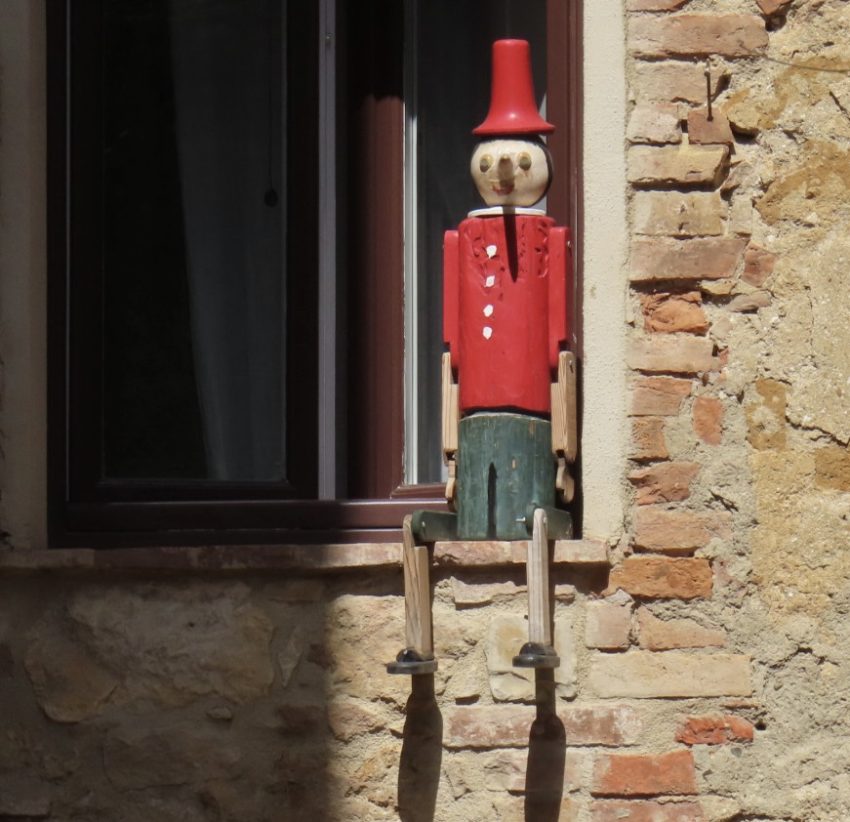
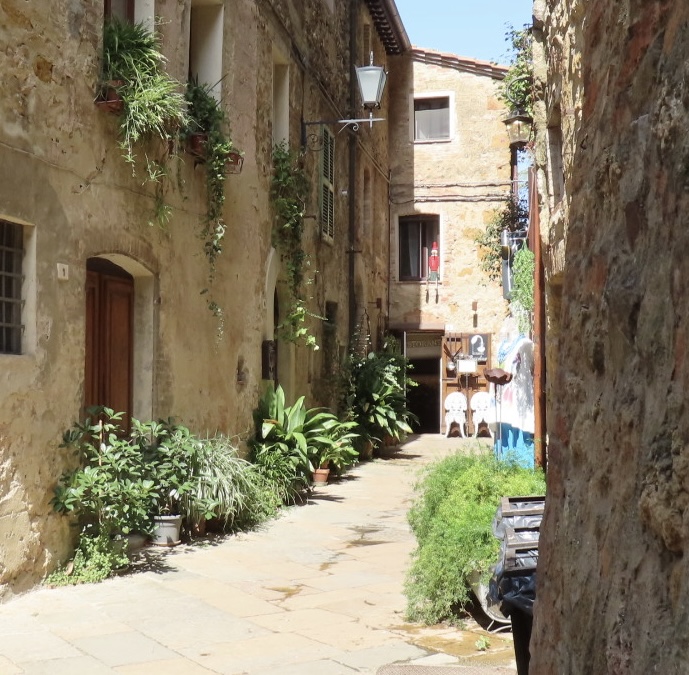


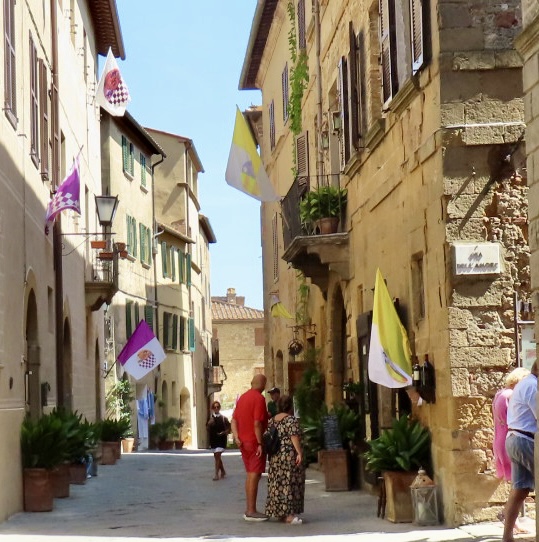

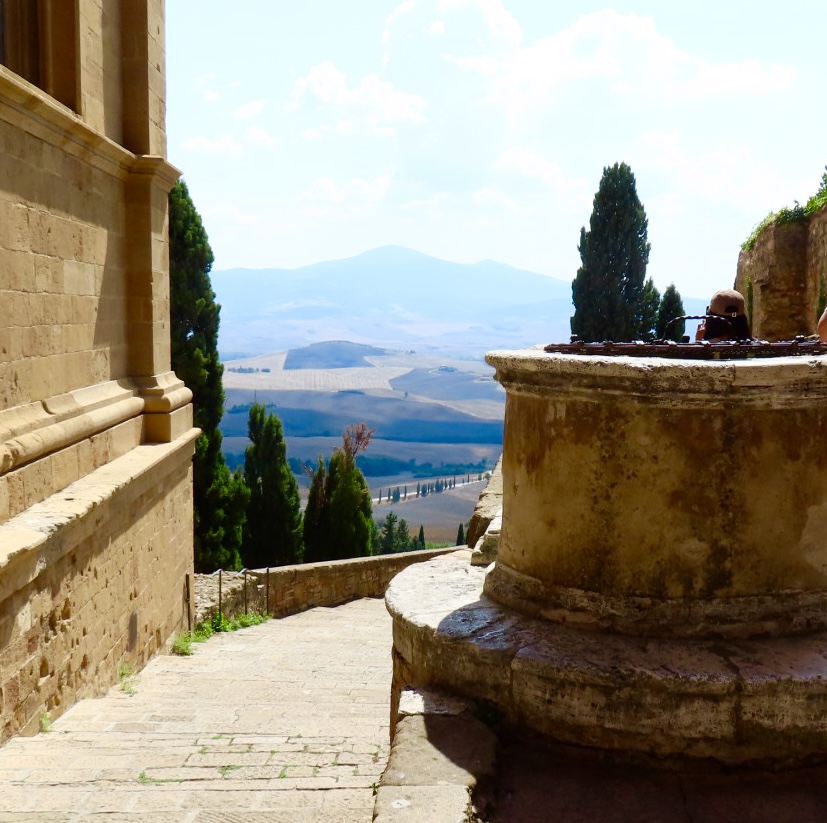
Our last stop this day was to be Montalcino, but it had started to lightning and thunder, so we cut the visit short. But I did get a few photos before we left.
The town is very high and the views were spectacular, of olive orchards, vineyards, and fields.








The next day we drove to Florence, part of the way on the back roads. We stopped in the little town of Montemerano, only 8 miles from Manciano.








Then, reluctantly, it was time to head north. We had a hard time finding the drop off for our car, which I loved by the way, a hybrid BMW. I ended up driving in Downtown Florence, a thing they tell you NOT to do. Well, after all the places I had driven it was a piece of cake!
A month in Europe Part 2 will be next, Florence, Salzburg, and Prague. Part 3 will be Berlin and Amsterdam.

